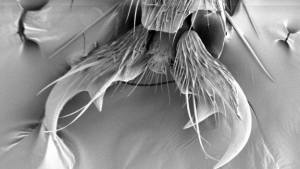Ants are well-known for building with their bodies, but a new study has shown that army ants can optimize traffic flow using bridges that move. Army ants are a predatory nomadic species, they raid other insect colonies and are always on the move, without a permanent nest. In this lifestyle, finding the shortest foraging path with sufficient workforce left over is crucial. The new research shows they adjust their bridges to find that balance. A gap in an ant’s path might be a daunting obstacle for the insect’s small body. But army ants in tropical forests of Central and South America work together to make shortcuts. Linking their bodies together, the army ants build bridges for their comrades to march across. That sounds like smart cooperation, but the ants go beyond that. Researchers have found that the ants seem to weigh the costs and benefits of making long, living bridges. If a shorter distance requires too many ant bodies, the ants appear to decide that it’s not worth it. Many species of ants show many complex, collective behaviors. Fire ants form rafts, bridges and tower structures, while weaver ants in Australia build chains that “sew” leaves together to make nests.
Researchers travelled to Panama to observe this species in its natural environment, hoping “to understand the simple rules that allow them to communicate and build the complex bridge structures. The team used a 3D-printed, angled platform that mimicked the ants’ natural environment but also allowed the scientists to adjust the path for their experiments. .”The ants started to form a small bridge at the tip of the angle, which then moved away, making the bridge bigger and bigger so as to shorten the path,” explained Mr Lutz, a PhD student at Princeton University in the US. “What was even more interesting was that the bridge didn’t move as far away as it possibly could. It tended to stop at some intermediate point.” If the angle to be bridged was wider, that “bridge migration” ceased even sooner
In the wild, a foraging trail contains several such bridges, and they respond to the intensity of the traffic overhead: “If you stop the traffic across the bridge, it breaks in 1-2 minutes, The researchers reasoned that the ants were facing a trade-off between a shorter, faster path and the number of ants that had to be immobilized in building the structure which would otherwise boost the community’ foraging power. From a foraging perspective, the shortest path is not necessarily the most efficient one.
“This is an elegant, quantitative study of the wonderful adaptive abilities of army ants,” commented Prof Nigel Franks, who runs an ant research lab at the University of Bristol. “The army ants are such effective raiders that they deplete their prey as they go. They are here today, gone tomorrow. “Using their bodies to build dynamic bridges and to cover “potholes” in their route makes sense to them, as opposed to spending time and energy bulldozing obstacles out of their way.”
“Artificial systems made of independent robots operating via the same principles as the army ants could build large-scale structures,” said Dr Reid, who was working at the New Jersey Institute of Technology when the study was conducted. “Such swarms could accomplish remarkable tasks, such as creating bridges to navigate complex terrain, plugs to repair structural breaches, or supports to stabilize a failing structure.”
For more information please visit: www.pnas.org


Comments are closed.